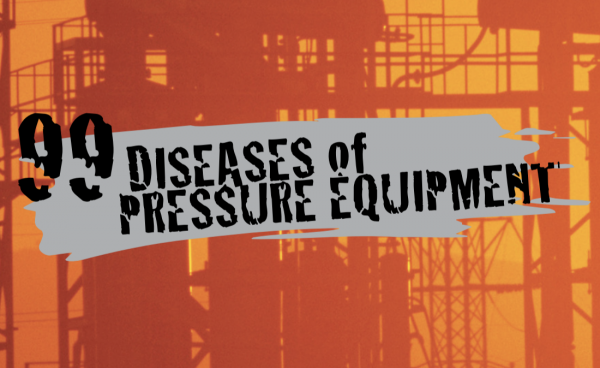Sulphuric Acid Corrosion is a well-known damage mechanism that manifests as general or localized corrosion in carbon steel and other alloys in acidic environments. Sulfuric acid corrosion is most commonly seen in sulfuric acid alkylation units and wastewater treatment plants where acid concentration, fluid velocity, operating temperatures, and acid carryover are not carefully controlled.
Susceptible Areas
Acid carryover into equipment and piping systems that were not constructed to resist sulfuric acid at certain concentrations and temperatures can lead to higher corrosion rates. Reactor effluent lines, reboilers, deisobutanizer overheads, and caustic treating systems are particularly vulnerable. Vessels handling sulfuric acid can also become severely corroded when cleaned for internal inspection.
While sulfuric acid corrosion most often manifests as general thinning, it can also be highly localized to weldments (especially in heat affected zones), crevices, and liquid vapor interfaces. The latter is most often the case in flare lines because of the ingress of oxygen. It is not uncommon to see a knife-like line of corrosion at the tops of lines carrying concentrated sulfuric acid and at elbows, especially in areas where maximum allowable velocities are exceeded.
Prevention/Mitigation
Sulfuric acid corrosion can be mitigated through proper material selection. While most process equipment can be constructed cost effectively out of carbon steel, areas where sulfuric acid is anticipated may require upgrades to more resistant alloys like Alloy 20, Alloy 904L, and Alloy C276. Moreover, the risk of sulfuric acid corrosion can be minimized if acid concentration levels, operating temperatures, flow velocities, and oxidizers/contaminants are properly managed.
Inspection Techniques
Ultrasonic Testing (UT) and Radiographic Testing (RT) are two nondestructive testing (NDT) techniques that have proven to be effective for detecting and measuring localized corrosion due to sulfuric acid. Permanently mounted thickness monitoring sensors can also be utilized to monitor corrosion rates. Vessels containing sulfuric acid should be considered for non-intrusive inspection to avoid the heightened risk for severe corrosion when introducing cleaning water. When clean-out is unavoidable, a post-cleaning inspection should be conducted to ensure no significant corrosion has developed prior to returning to service.
References
- API RP 571, “Damage Mechanisms Affecting Fixed Equipment in the Refining Industry”, Third Edition, American Petroleum Institute, 2020.
- Reynolds, J., 2004, “99 Diseases of Pressure Equipment: Sulfuric Acid,” Inspectioneering Journal, The Woodlands, Texas.
Related Topics
- Brittle Fracture
- Carburization
- Cavitation
- CO2 Corrosion
- Cooling Water Corrosion
- Corrosion Fatigue
- Corrosion Under Insulation (CUI)
- Cracking
- Decarburization
- Embrittlement
- Erosion Corrosion
- Fatigue (Material)
- Flue Gas Dew Point Corrosion
- Graphitization
- Green Rot
- High Temperature Hydrogen Attack (HTHA)
- High-Temperature Creep
- Hydrochloric (HCl) Acid Corrosion
- Hydrofluoric (HF) Acid Corrosion
- Hydrogen Embrittlement
- Hydrogen Stress Cracking
- Liquid Metal Embrittlement (LME)
- Metal Dusting
- Microbiologically Influenced Corrosion (MIC)
- Naphthenic Acid Corrosion (NAC)
- Phosphoric Acid Corrosion
- Pitting Corrosion
- Spheroidization (Softening)
- Stress Assisted Corrosion
- Sulfidation Corrosion
- Thermal Fatigue
- Vibration-Induced Fatigue
- Wet H2S Damage
Relevant Links
Topic Tools
Share this Topic
Contribute to Definition
We welcome updates to this Integripedia definition from the Inspectioneering community. Click the link below to submit any recommended changes for Inspectioneering's team of editors to review.
Contribute to Definition




















